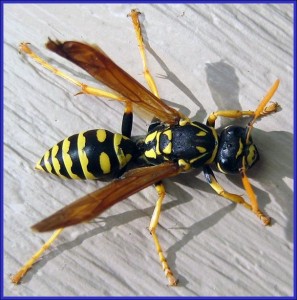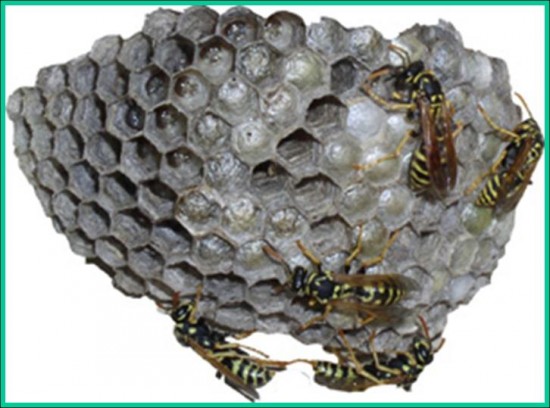
European Paper Wasp
European Paper Wasp (Polistes dominulus)
European Paper Wasp is an Old World species that has a native range from Europe to China. The species is by far the most common Polistes in Western Europe. P. dominulus has successfully invaded the New World, both in South America (Chile) and North America–and is rapidly expanding its range in the United States. It was first discovered in the US in Cambridge, Massachusetts in 1981. Since then it has spread west to Wisconsin and at least as far south as Virginia. It was recently discovered in Sacramento, California and Washington State. It was first found in Michigan in 1994. The European Paper Wasp has a high rate of reproductive increase, and therefore is an excellent invader.
A Cornell University researcher has found that certain female wasps, without nests of their own, “sit and wait” for an opportunity to adopt an orphaned nest or hijack a nest from another queen. These sit-and-wait female wasps prefer to adopt the most mature nests, probably because these nests will produce workers the soonest, and colonies with workers are very likely to survive. Once a queen adopts a nest she will eat the former queen’s eggs and young larvae and replace them with her own eggs. The older larvae and pupae, which belonged to the former queen, are allowed to complete development and may eventually help rear the adopting female’s offspring. Ferocious hunters, paper wasps feast on caterpillars.
You can identify a paper wasp by its thin wasp-like waist and the paper nest, which usually hangs downward and has open cells on the bottom. The nests are common under eaves and inside outbuildings. No mud is found in paper wasp nests. The hornets and yellowjackets have thicker bodies and build domes of paper enclosing the cells where the young are raised, which often take on the classic “football” shape of cartoon fame. The European Paper wasp is colored black and yellow like a yellowjacket and is slightly smaller than our native brown and tan Common Paper wasp (Polistes fuscatus).
The European prefers to nest in cavities and seems to attack people with much less provocation than the native paper wasp. The European Paper wasp prefers cavities for its nests and will build on a vertical surface as long it is protected by some type overhang.
The genus Polistes has a world-wide distribution and in Europe and North America its colonies outnumber all the other social wasps combined. The nests are usually founded by a single Queen or Foundress, who starts her nest in May having hibernated as a mated queen throughout the winter often in the company of all the other mated females from their parental nest. The original foundress is generally joined by a number of auxiliary queens (usually 2-6) in June, these are known as associate foundresses. These are usually treated as subordinates by the original foundress and demonstrate their subordinate place through the adoption of submissive postures, and in the gathering of food and regurgitating some of it to the dominant queen or primary foundress. The dominant foundress actively seeks to prevent her associates from laying eggs and will eat their eggs when she notices them if they do. In some nests, a dominancy hierarchy may arise with one or two of the associate foundresses having a limited laying success. It is interesting to note that the ovaries of dominated queens tend to regress in direct proportion to the amount domination she experiences, so that by the time sexual larva are being produced in late July most of the associate foundresses are no longer reproductively functional.
Complete development of the larvae takes about 48 days and the first brood emerges in June. By late July 200 workers may have been raised, but mortality (death) mostly as a result of predation means that in most cases far fewer workers than this are available to start raising the sexual larvae. New queens and males start appearing in August and their numbers continue to increase until they are ready to leave the nest in early September. By this time their hunger will have disrupted the nest as they will be preventing any further larvae from being fed by eating all the food collected by the workers.
Paper wasps can be controlled by spraying the nests with one of the many long-range Wasp and Hornet Sprays.





 Print
Print Email
Email




